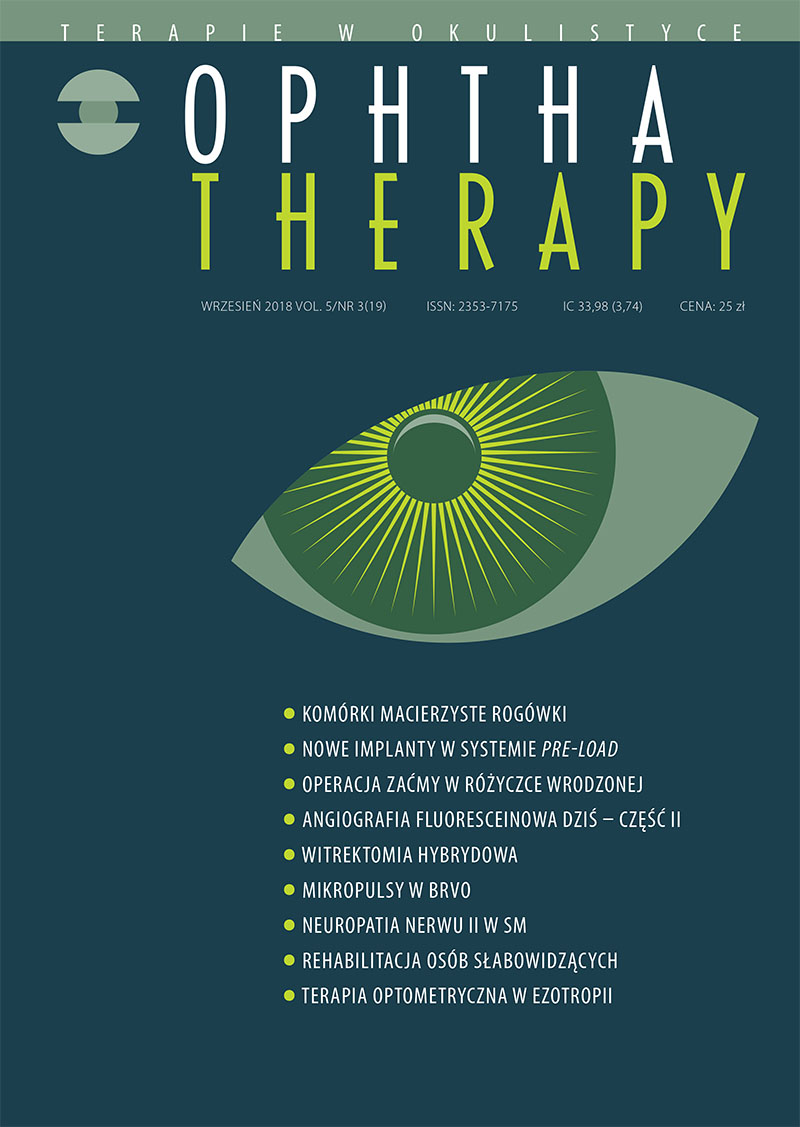The position of fluorescein angiography among modern imaging techniques in ophthalmology – part II
Main Article Content
Abstract
Fluorescein angiography is one of the oldest forms of imaging in ophthalmology. However, with the advent of optical coherence tomography in everyday clinical practice, indications for performing fluorescein angiography have significantly changed. In the following paper, modern application of fluorescein angiography in diagnostics of retinal diseases has been outlined as well as main recommendations for its performance. It has been compared with optical coherence tomography and OCT angiography. Author presents main directions for development of this technique.
Downloads
Article Details

This work is licensed under a Creative Commons Attribution-NonCommercial-NoDerivatives 4.0 International License.
Copyright: © Medical Education sp. z o.o. License allowing third parties to copy and redistribute the material in any medium or format and to remix, transform, and build upon the material, provided the original work is properly cited and states its license.
Address reprint requests to: Medical Education, Marcin Kuźma (marcin.kuzma@mededu.pl)
References
2. Bottoni F, Fatigati G, Carlevaro G et al. Fundus flavimaculatus and subretinal neovascularization. Graefes Arch Clin Exp Ophthalmol. 1992; 230(5): 498-500.
3. Battaglia Parodi M, Da Pozzo S, Ravalico G. Photodynamic therapy for choroidal neovascularization associated with pattern dystrophy. Retina. 2003; 23(2): 171-6.
4. Quijano C, Querques G, Massamba N et al. Type 3 choroidal neovascularization associated with fundus flavimaculatus. Ophthalmic Res. 2009; 42(3): 152-4.
5. Gass JDM. Stereoscopic Atlas of Macular Diseases: Diagnosis and Treatment. 3rd ed. CV Mosby, St. Louis 1987: 46-59.
6. Daurich A, Matet A, Dirani A et al. Central serous chorioretinopathy: Recent findings and new physiopathology hypothesis. Prog Retin Eye Res. 2015; 48: 82-118.
7. Konstantinidis L, Mantel I, Zografos L et al. Intravitreal ranibizumab in the treatment of choroidal neovascularization associated with idiopathic central serous chorioretinopathy. Eur J Ophthalmol. 2010; 20(5): 955-8.
8. Bonini Filho MA, de Carlo TE, Ferrara D et al. Association of Choroidal Neovascularization and Central Serous Chorioretinopathy With Optical Coherence Tomography Angiography. JAMA Ophthalmol. 2015; 133(8): 899-906.
9. Royal College of Ophthalmologists. Retinal Vein Occlussion Guidelines 2015. www.rcophth.ac.uk.
10. Shilling JS, Kohner EM. New vessel formation in retinal branch vein occlusion. Br J Ophthalmol. 1976; 60: 810-5.
11. Yannuzzi LA, Bardal AM, Freund KB et al. Idiopathic macular telangiectasia. Arch Ophthalmol. 2006; 124(4): 450-60.
12. Gass JD, Blodi BA. Idiopathic juxtafoveolar retinal telangiectasis. Update of classification and follow-up study. Ophthalmology. 1993; 100: 1536-6.
13. Spaide RF, Klancnik JM Jr, Cooney MJ et al. Volume-Rendering Optical Coherence Tomography Angiography of Macular Telangiectasia Type 2. Ophthalmology. 2015; 122(11): 2261-9.
14. Launbjerg K, Bache I, Galanakis M et al. von Hippel-Lindau development in children and adolescents. Am J Med Genet A. 2017; 173(9): 2381-94.
15. Early diagnosis of choroidal melanoma. Br J Ophthalmol 1980; 64(3): 146-7.
16. Tarkkanen A, Laatikainen L. Fluorescein angiography in the long-term follow-up of choroidal melanoma after conservative treatment. Acta Ophthalmol (Copenh). 1985; 63(1): 73-79.
17. Price LD, Au S, Chong NV. Optomap ultrawide field imaging identifies additional retinal abnormalities in patients with diabetic retinopathy. Clin Ophthalmol. 2015; 9: 527-31.
18. Silva PS, Horton MB, Clary D et al. Identification of Diabetic Retinopathy and Ungradable Image Rate with Ultrawide Field Imaging in a National Teleophthalmology Program. Ophthalmology. 2016; 123(6): 1360-7.
19. Ghasemi Falavarjani K, Wang K, Khadamy J et al. Ultra-wide-field imaging in diabetic retinopathy; an overview. J Curr Ophthalmol. 2016; 28(2): 57-60.
20. Silva PS, Cavallerano JD, Haddad NM et al. Peripheral Lesions Identified on Ultrawide Field Imaging Predict Increased Risk of Diabetic Retinopathy Progression over 4 Years. Ophthalmology. 2015; 122(5): 949-56.
21. Wessel MM, Nair N, Aaker GD et al. Peripheral retinal ischaemia, as evaluated by ultra-widefield fluorescein angiography, is associated with diabetic macular oedema. Br J Ophthalmol. 2012; 96(5): 694-8.
22. Talks SJ, Manjunath V, Steel DH et al. New vessels detected on wide-field imaging compared to two-field and seven-field imaging: implications for diabetic retinopathy screening image analysis. Br J Ophthalmol. 2015; 99(12): 1606-9.
23. Soliman AZ, Silva PS, Aiello LP et al. Ultra-wide field retinal imaging in detection, classification, and management of diabetic retinopathy. Semin Ophthalmol. 2012; 27(5-6): 221-7.
24. Jia Y, Bailey ST, Wilson DJ et al. Quantitative optical coherence tomography angiography of choroidal neovascularization in age-related macular degeneration Ophthalmology. 2014; 121: 1435-44.
25. Al-Sheikh M, Tepelus TC, Nazikyan T et al. Repeatability of automated vessel density measurements using optical coherence tomography angiography. Br J Ophthalmol. 2017; 101: 449-52.
26. Hwang TS, Gao SS, Liu L et al. Automated quantification of capillary nonperfusion using optical coherence tomography angiography in diabetic retinopathy. JAMA Ophthalmol. 2016; 134: 367-73.
27. Zhang M, Hwang TS, Dongye C et al. Automated quantification of nonperfusion in three retinal plexuses using projection-resolved optical coherence tomography angiography in diabetic retinopathy. Invest Ophthalmol Vis Sci. 2016; 57: 5101-6.
28. Liu L, Gao SS, Bailey ST et al. Automated choroidal neovascularization detection algorithm for optical coherence tomography angiography. Biomed Opt Express. 2015; 6: 3564-76.
29. Huang D, Jia Y, Rispoli M et al. Optical coherence tomography angiography of time course of choroidal neovascularization in response to anti-angiogenic treatment. Retina. 2015; 35: 2260-4.

